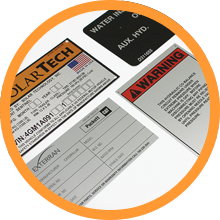The following information is by no means exhaustive but meant to provide a basic understanding and general overview of MIL-STD-130.
What is the MIL-STD-130?
Also known as the “Identification Marking of U.S. Military Property,” MIL-STD-130 provides directions as to how to mark items sold to the Department of Defense (DoD). MIL-STD-130N is the latest version of the standard, published on November 16, 2012.
The standard describes materials allowed and specifies text sizes, fonts, formats, syntax, and rules regarding marks on a part, location of the ID marks, as well as instructions on unique situations (VIN numbers, smartphone IDs, etc). When coming upon any conflicts between MIL-STD-130N and documents cited within, the standard will always take precedence.
Why have an IUID registry?
The Department of Defense wants to make it easy to find information on all things owned by providing a single location where assets are logged with purchase date, price, and dates items are sent for repairs or labeled as inefficient or no longer in use.
A DoD user is immediately connected to the asset record in the DoD UID Database by scanning the asset’s IUID data matrix, which is a square and pixelated barcode. Only a few label-making software solutions and scanner-verifiers achieve the required syntax of the data matrix. Beware – while some commercial imitations look similar, they will not pass verification, which is a requirement of the standard.
What are the allowed methods of marking?
The standard requires that qualified government-provided property and deliverables be marked with human-readable information (exceptions may apply), and a machine-readable 2D data matrix barcode. The requirements for items that are deemed UID are different than the requirements for items that are deemed non-UID.
Marking methods are often dictated by specificity of use and the environment. Some of the most commonly-used methods include:
- Abrasive blasting
- Acid etching
- Dot peening
- Laser engraver
- Metal stamping
- Photo anodizing (Metalphoto)
- Rotary engraver
What are the barcode requirements?
The barcode must meet quality specifications, pass a verification process (a grade of B or better), and be permanent (capable of withstanding environmental tests and cleaning procedures associated to the specific item and other items to which it is affixed).
What constitutes proper marking?
Many specifications must be met to make a proper mark. All marking must be applied to a metal or stiff plastic identification plate, band, tag, or label, which is to be securely fashioned to the item. Alternatively, the marking can be directly applied to the surface of the item.
The marking must be in a visible location (whenever possible) so it can be easily read during operation and use. The marking must withstand normal environmental conditions (cleaning and rebuilding process included).
If any of the above conditions are not realistic using an MRI (machine-readable information) marking, a temporary marking needs to be used until the item is rebuilt.
What if there is limited space for information?
If there is not enough space for a proper then only the most essential information needs to be marked. Such includes:
- EID (Enterprise Identifier)
- Serial Number
- Part Number or Lot/Batch Number
For unique situations, where there is no room for a proper IUID (item unique identification), such markings may be placed on the associated item’s packaging.
What is the minimum size of allowed information?
The recommended minimum height for text is 0.2 centimeters, or 0.08 inches, or 6 points. Letters shall be ALL-CAPS in a sans-serif font such as:
- ARIAL
- FUTURA
- TREBUCHET MS
All numbers should be in Arabic font.
For more information about MIL-STD-130, contact Camcode, our industry partner and recognized worldwide leader in the manufacture of labels for MIL-STD-130.

